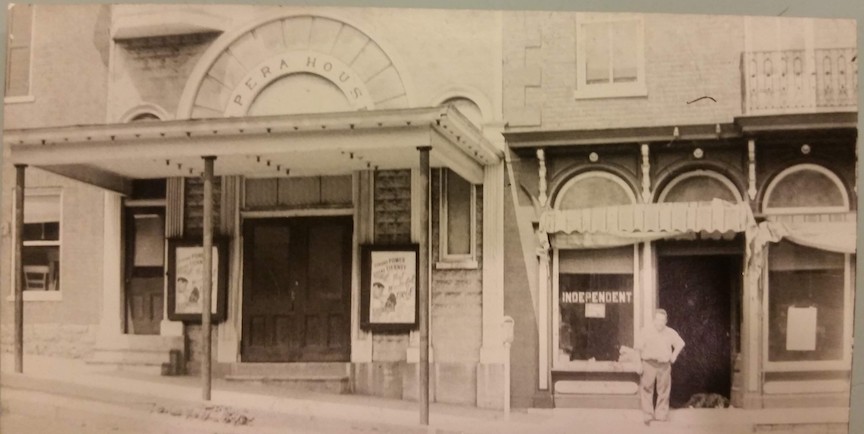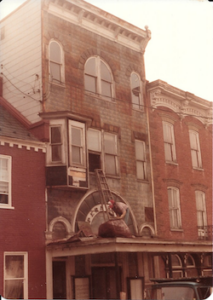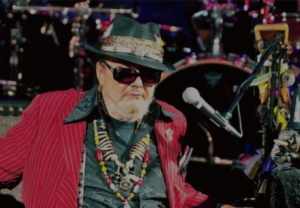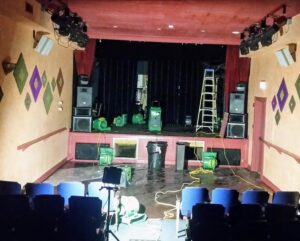About Us
A history of the Shepherdstown Opera House
The Rise of Opera Houses
An “opera house” sounds like a civilized place for entertainment — exactly what towns and cities across the United States were intending when they built these new types of venues to attract the itinerant performers who were crisscrossing the country in the late 19th and early 20th centuries.
The term “vaudeville” would eventually stick as a general term for the popular performance of this era between the 1870s and 1920s. People across the country could attend shows featuring a broad variety of acts, featuring both local talent and touring acts. Performances could be one-man bands, traveling repertoire troops, jugglers, magicians, singers, lecturers and even animal acts. By the early 20th century, moving picture projectionists joined the mix, showing silent films on hand-cranked projectors.
Vaudeville —A Nationwide Entertainment Network
Author Ann Satterthwaite chronicles the rise and fall of the main street opera house from the 1870s through the 1920s in her book Local Glories. It was a good run, with some western gold and silver boom towns hosting palatial theaters seating thousands and regular circuits competing for the top performers such as Sara Bernhardt, Harry Houdini, John Philip Sousa, and Mark Twain.

Opera houses brought a national culture of popular entertainment to many small towns in an era when railroad travel coast to coast was easy, but getting one town over was still done by horse or on foot. According to Satterthwaite, the number of opera house venues once numbered in the thousands.
With the advent of “talking” films at the end of the 1920s, opera houses gave way to “movie palaces,” many designed with exotic themes and lavish seating. Today, the list of opera houses still functioning as entertainment venues can fit on a single sheet of paper.
Shepherdstown Builds Its Opera House
Upton Scott Martin purchased the property for Shepherdstown’s Opera House in December 1909. There was a small wood house on the new property which he had torn down. The Opera House was ready for shows by August of 1910. There was no plumbing or electricity installed, so construction was a bit simpler back then.
In 1910, Shepherdstown still had a 19th century aspect — a contemporary photo shows a parade downtown, with the main street filled with horses and carriages. Up the street, Jefferson Security Bank still occupied the Billmyer building (today’s Admiral Analog’s record store). Licklider’s general store was next door (the current Press Room restaurant). Trains stopped at the Norfolk & Western train station. The Volunteer Fire Company still occupied the old market house in the center of King Street. The Entler Hotel was doing a thriving business (and not yet damaged by the 1912 fire).
The first few years at the Opera House saw a rotating cast of performers. Several of the town police officers who purchased a hand-cranked projector to show motion picture shows in the “family theater.” Various local organizations held “chaperoned dances” for youth upstairs.


When Clifford S. Musser needed a space for the offices and printing equipment for his newspaper, The Independent, he became the first permanent tenant of the Opera House in March 1914. All of his typesetting and printing equipment was hand-operated (and hand-carried up) on the third floor). In May of that year, Musser, with his wife Ada, took on the management of the theater too. By April 1915, the Musser family had moved into a newly constructed apartment suite on the second floor. They eventually purchased the building from Martin in 1926.
From Silent Films To Hollywood’s Golden Age
The Musser family ran the theater through five decades, making significant upgrades with the advent of “talkies” at the end of the 1920s, including ramping the auditorium floor, constructing an enclosed projection booth in front of the balcony, installing a large canopy over the sidewalk in front, and wiring the building for electricity. The theater maintained a regular schedule of movies, typically 4 nights a week, into the 1950s. According to local residents who recall attending as kids, the theater was showing its age by then, and still had no public restrooms or air conditioning — likely not very attractive to the mid-century sensibilities of adults and teenagers who had access to automobiles and access to other options for a night out watching a movie (including the Ford Drive-In near Harpers Ferry and the Sky-Vue Drive-In between Martinsburg and Shepherdstown). The last movie advertisement published in The Independent, for 23 Paces to Baker Street, appeared in May 1957.

The Independent newspaper continued operations (both in the Opera House and the Licklider building next door) until 1974, and the younger of the Musser’s two sons occupied the 2nd floor residence in the Opera House until 1983. In 1984, a local resident, Jack Skuce purchased both properties. Skuce had grade plans to create an entertainment and dining complex in downtown Shepherdstown, but his dreams exceeded his financing and he soon put both buildings up for sale.
Art House Films & Live Music

In the summer of 1987, Rusty and Pam were motorcycling through Shepherdstown on a weekend jaunt and found themselves captivated by the Opera House. Skuce had managed to restore the front of the building, but the theater still sat much as it was when it was locked up in 1957, just a lot more decrepit and dusty. By 1987 Rusty and Pam were the new owners of the Opera House and they began the renovations to make it their home and reopen the theater. On February 14, 1992, they welcomed patrons for a screening of Meeting Venus (a 1991 film about the mis-adventures of staging a 19th century German opera in 20th century Paris) in the newly-refurbished theater, now offering restrooms, air conditioning — and popcorn!
Rusty ran the theater as an art house cinema and it was his passion for the next two decades. In 1995, Rusty partnered with some local individuals to present live music on an occasional basis, eventually adding a performance sound system and launching the OperaHouseLive.com website in 2004 to support an ongoing schedule of live performance alongside the regular schedule of movies. Rusty switched from 35 millimeter film to digital projection later in the decade, but the film industry’s shift to earlier distribution of newly-released movies on DVD had a noticeable affect on ticket sales. By the spring of 2008, Pam and Rusty had put a “for sale” sign on the Opera House, hoping someone else might have the energy to sustain the theater as a viable business.
Independent filmmaker Lawrence Cumbo and his wife Julie were returning to Shepherdstown in 2010 after an assignment in New Zealand and saw the sign still in the window. By Halloween that year, they had purchased the building and were enthusiastic to try new ideas to bring audiences into the theater. Cumbo’s initial plan was to continue running the Opera House as an art house theater, leveraging his own experience in the industry to expand the offerings. Still, changing movie-going habits proved to be too much of an obstacle and Cumbo began to shift the mix to predominantly live music.

In September of 2012, the Opera House hosted legendary musician Dr. John as part of a documentary directed by Cumbo that was later broadcast on the Smithsonian Channel in 2014. Cumbo continued to focus on hosting live music for the next few years, but the travel required for his film-making career did not fill well with the need for advance planning and regular scheduling of live production shows.
By 2017, when Harriet and Steve Pearson were regular weekend visitors to Shepherdstown, the Opera House was open infrequently for performances and struggling financially. The theater had been for sale informally for a year or so, but in December 2017 Cumbo hired a real estate broker to market the building. With the prospect of the property being sold and converted into an apartment building or office space, the Pearsons made a decision after attending a concert the night before —they would make an offer to purchase the Opera House and a commitment to keep it operating as a theater. By the end of the month they had an agreement and closed the deal a few months later in March 2018.
Rebuilding The Shepherdstown Opera House

As Harriet and Steve took on the tasks of building up the performance schedule for 2018 and organizing neglected maintenance, the future of the theater looked brighter than it had in many years. But on May 16, Steve received an early morning phone call with an ominous report—water was raining from the ceiling over the stage. What turned out be nearly 5,000 gallons of water from a burst pipe in the apartment above ultimately flooded into the theater.
Initially, Harriet & Steve thought that the repairs would be minor and a short interruption of their plans. However, as the damaged walls were opened up, bigger problems became apparent, including significant failures in the structure and problematic modifications made during earlier renovations. Over the next few years, the entire building underwent extensive renovation and reopened in the spring of 2023. The restored Opera House preserves historic elements of the buildings with improved accessibility and updated amenities to continue a second century of Shepherdstown’s family owned & operated theater.
For news and updates, visit our blog or join our email list.
Check out our calendar for a full list of upcoming events.